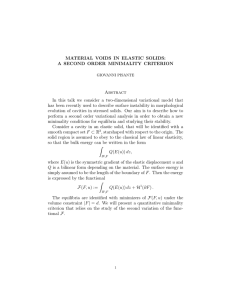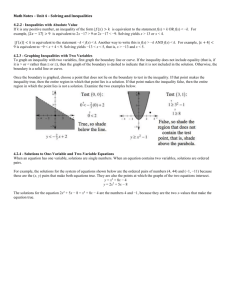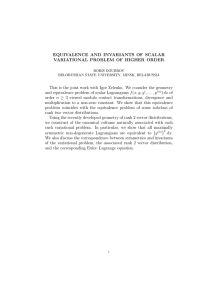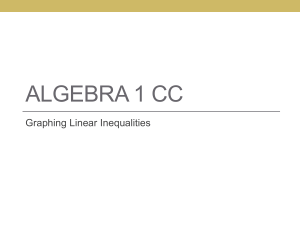Mem. Differential Equations Math. Phys. 38 (2006), 141–145 R. Gachechiladze
advertisement
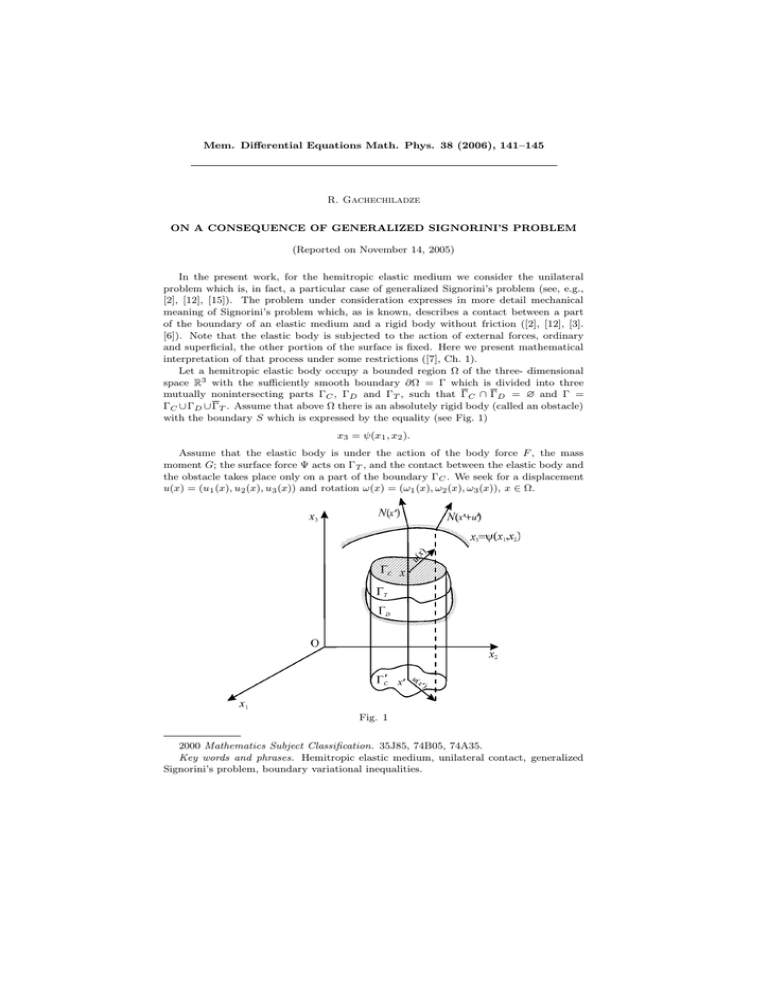
Mem. Differential Equations Math. Phys. 38 (2006), 141–145 R. Gachechiladze ON A CONSEQUENCE OF GENERALIZED SIGNORINI’S PROBLEM (Reported on November 14, 2005) In the present work, for the hemitropic elastic medium we consider the unilateral problem which is, in fact, a particular case of generalized Signorini’s problem (see, e.g., [2], [12], [15]). The problem under consideration expresses in more detail mechanical meaning of Signorini’s problem which, as is known, describes a contact between a part of the boundary of an elastic medium and a rigid body without friction ([2], [12], [3]. [6]). Note that the elastic body is subjected to the action of external forces, ordinary and superficial, the other portion of the surface is fixed. Here we present mathematical interpretation of that process under some restrictions ([7], Ch. 1). Let a hemitropic elastic body occupy a bounded region Ω of the three- dimensional space R3 with the sufficiently smooth boundary ∂Ω = Γ which is divided into three mutually nonintersecting parts ΓC , ΓD and ΓT , such that ΓC ∩ ΓD = ∅ and Γ = ΓC ∪ΓD ∪ΓT . Assume that above Ω there is an absolutely rigid body (called an obstacle) with the boundary S which is expressed by the equality (see Fig. 1) x3 = ψ(x1 , x2 ). Assume that the elastic body is under the action of the body force F , the mass moment G; the surface force Ψ acts on ΓT , and the contact between the elastic body and the obstacle takes place only on a part of the boundary ΓC . We seek for a displacement u(x) = (u1 (x), u2 (x), u3 (x)) and rotation ω(x) = (ω1 (x), ω2 (x), ω3 (x)), x ∈ Ω. Fig. 1 2000 Mathematics Subject Classification. 35J85, 74B05, 74A35. Key words and phrases. Hemitropic elastic medium, unilateral contact, generalized Signorini’s problem, boundary variational inequalities. 142 Γ0C is the orthogonal projection of the surface ΓC onto the plane x1 0x2 , x0 = (x1 , x2 ), 0 u (x) = (u1 (x), u2 (x)), x = (x0 , x3 ) and u = (u0 , u3 ). Since upon deformation some part ΓC of the surface Γ remains always below S, it is clear that x3 + u3 (x) ≤ ψ(x0 + u0 ). (1) Let ψ be a twice continuously differentiable concave function. Then after linearization, assuming that the body Ω admits “small displacements”, the conditions (1) take the form u(x) · N (x0 ) ≤ ϕ(x), x ∈ ΓC , p where ϕ(x) = (ψ(x0 ) − x3 ) 1 + |(grad ψ)(x0 )|2 , and (2) s ∂ψ ∂ψ 2 ∂ψ 2 ∂ψ ,− ,1 1+ + N (x ) = (N1 (x ), N2 (x ), N3 (x )) = − ∂x1 ∂x2 ∂x1 ∂x2 0 0 0 0 is the exterior normal of the rigid obstacle at the point (x0 , ψ(x0 ) ∈ S. The conditions (2) differ from those of the classical statement of Signorini’s problem in which instead of N there appears the exterior normal n of the surface Γ C . The passage from the normal N to n can be realized under additional restrictions; for example, we assume that the body Ω admits “small displacements”, and the surfaces Γ C and S are sufficiently close to consider them parallel (in most cases this is impossible). Thus to derive the conditions (2), we need less restrictions than in the general case, and they describe the mechanical meaning of the problem more precisely than the standard Signorini’s conditions. The equilibrium equation of the hemitropic elastic body has the form ([11]) L(∂)U (x) + F (x) = 0, where x ∈ Ω, L(1) (∂) ... L(2) (∂) L(∂) = . . . . . . . . . . . . . . . . . . . . . L(3) (∂) .. L(4) (∂) (3) 6×6 is the matrix differential operator corresponding to the statical state of the medium, U (x) = (u(x), ω(x)), u(x) = (u1 (x), u2 (x), u3 (x)) is the displacement vector, ω(x) = (ω1 (x), ω2 (x), ω3 (x)) is the rotation vector, and F (x) = (F (x), G(x)). Introduce the matrix differential stress operator T (1) (x, ∂, n) ... T (2) (x, ∂, n) T (x, ∂, n) = . . . . . . . . . . . . . . . . . . . . . . . . . . . . . . , . T (3) (x, ∂, n) .. T (4) (x, ∂, n) 6×6 where n(x) is the exterior normal to Ω at the point x ∈ Γ. L(j) (∂) and T (j) (x, ∂, n) (j = 1, 2, 3, 4) are matrix differential operators of dimension 3 × 3. τ U (x) = T (1) (x, ∂, n)u(x) + T (2) (x, ∂, n)ω(x) is the vector of power stress; µU (x) = T (3) (x, ∂, n)u(x) + T (4) (x, ∂, n)ω(x) is the vector of moment stress. In the sequel, by H s (Ω) and H s (Γ) (s ∈ R) we will denote the real Sobolev–Slobodetski’s spaces (see (13], [16]). Below, we will deal with weak solutions of the equation (3) for F ∈ (L2 (Ω))6 , i.e. with the functions U ∈ (H 1 (Ω))6 for which the integral identity Z Z E(U, Φ) dx = F · Φ dx, ∀Φ ∈ (C0∞ (Ω))6 Ω Ω is fulfilled; here E(U, V ) is the bilinear form corresponding to the operator L(∂). It should be noted that if U ∈ (H 1 (Ω))6 and L(∂)U ∈ (L2 (Ω))6 , then using Green’s formula, we 143 1 can determine rΓ T (x, ∂, n)U (x) as a functional of the class (H − 2 (Γ))6 by the relation Z Z hrΓ T (x, ∂, n)U (x), Φ(x)iΓ = E(U, V ) dx + L(∂)U · V dx, Ω Ω 1 ∀Φ ∈ (H 2 (Γ))6 and ∀V ∈ (H 1 (Γ))6 , rΓ V = Φ; 1 here and in what follows, h·, ·i denotes the dual relation between the spaces (H − 2 (Γ))6 1 2 (Γ))6 . and (H We consider the following Problem. Find a vector function U ∈ (H 1 (Ω))6 , which is a weak solution of the equation (3), satisfying the conditions rΓD U (x) = 0, rΓT T (x, ∂, n)U (x) = Ψ(x); rΓC u(x) · N (x0 , ψ(x0 )) ≤ ϕ(x), 0 0 (4) rΓC τ U (x) · N (x0 , ψ(x0 )) ≤ 0; 0 0 hrΓ τ U (x) · N (x , ψ(x )), rΓ u(x) · N (x , ψ(x )) − ϕ(x)iΓC = 0; C C h i rΓ τ U (x) − rΓ τ U (x) · N (x0 , ψ(x0 )) N (x0 , ψ(x0 )) = 0, rΓ µU (x) = 0, C C C (5) (6) (7) where F = (F, G) ∈ (L2 (Ω))6 , Ψ ∈ (L2 (ΓN ))6 , and ϕ is the function defined above. For the sake of brevity, instead of u(x) · N (x0 , ψ(x0 )), τ U (x) · N (x0 , ψ(x0 )) and τ U (x) − [τ U (x) · N (x0 , ψ(x0 ))]N (x0 , ψ(x0 )) we will write, respectively, uN (x0 ) , [τ U ]N (x0 ) and [τ U ]s(x0 ) (tangential constituent of the power stress). The corresponding variational inequality has the form: find a vector function U = (u, ω) ∈ K such that ∀V ∈ K the inequality Z Z Z E(U, V − U ) dx ≥ F · (V − U ) dx + Ψ · (V − U ) dΓ (8) Ω Ω ΓT holds, where the convex closed set K is given by the formula n o K = U = (u, ω) ∈ (H 1 (Ω))6 : rΓC uN (x0 ) (x) ≤ ϕ; rΓD U = 0 . We can prove that the variational inequality (8) is equivalent to the physical problem (3)–(7). To reduce (8) to a boundary variational inequality, we reduce the problem (3)–(7) by means of an auxiliary problem (which will be formulated below) to the homogeneous (F = 0) problem. Let U0 = (u0 , ω0 ) ∈ (H 1 (Ω))6 be a weak solution of the equation (3), rΓD U0 = 0 and rΓ\Γ T (x, ∂, n)U0 (x) = 0. D As is known, there exists a unique solution of the above-mentioned problem. Therefore the vector function U ∗ = U − U0 will, instead of the condition (3), satisfy the condition (instead of U ∗ we write again U ) L(∂)U = 0 (9) and the first inequality (5) will be fulfilled by replacing ϕ by ϕ0 :≡ ϕ − rΓC (o0 )N (x0 ) . All the rest conditions of the problem remain unchanged. Introduce the Steklov–Poincaré operator defined by the relation n o+ 1 e (x) Af = T (x, ∂, n)Gf , ∀f ∈ (H 2 (Γ))6 , Γ where e (x) = Gf Z χ(x − y)H−1 f (y) dy Γ Γ is representable as a single layer potential (for the properties of functions representable in the form of the potential, see [8], [1], [10]), χ is the fundamental solution of the equation 144 (9), H is the direct value on the boundary Γ of the single layer potential, H−1 is the operator inverse to H, and n o+ e (x) e (z). T (x, ∂, n)Gf = lim T (z, ∂z , n(x))Gf Γ Ω3z→x∈Γ We prove that the operator A has the following properties ([5], [9]): 1 1 1 1) A : (H 2 (Γ))6 → (H − 2 (Γ))6 ; hAf, f iΓ ≥ 0, ∀f ∈ (H 2 (Γ))6 ; 1 2) hAf, giΓ = hAg, f iΓ , ∀f, g ∈ (H ( 2 (Γ))6 ; 2 3) hAf, f iΓ ≥ ckP f k 1 , where I \ P is the operator of orthogonal projection of the 2 ,Γ 1 space (H 2 (Γ))6 onto the kernel of the equation hAf, f iΓ = 0. Consider now the convex closed set n o 1 K1 = h ∈ (H 2 (Γ))6 : h = (ξ, η), rΓ h = 0, rΓ ξN (x0 ) (x) ≤ ϕ0 (x) D C and the boundary variational inequality: find h0 = (ξ0 , η0 ) ∈ K1 such that ∀h ∈ K1 the inequality hAh0 , h − h0 iΓ ≥ hΨ, rΓT (h − h0 )iΓT (10) is fulfilled. Again, we can prove that the boundary variational inequality (10) is equivalent to the physical problem (9), (4), (5)ϕ0 , (6), (7) ((5)ϕ0 is, in fact, the condition (5) with the function ϕ0 ) in the following sense: if h0 ∈ K1 is a solution of the inequality (10), then e 0 ∈ (H 1 (Ω))6 is a solution of the physical problem (9), (4), (5)ϕ , (6), (7), and vice Gh 0 versa, if U ∈ (H 1 (Ω))6 is a solution of that problem, then h0 = rΓ U is a solution of the variational inequality (10). In its turn, the problem of solvability of the variational inequality (10) is reduced to that of minimization on the set K1 of the energy functional Z 1 Φ(h) = hAh, hi − Ψ · rΓT h dΓ, ∀h ∈ K1 . 2 ΓT The functional Φ on the set K1 is strictly convex, and by virtue of the properties (1)–(3) the operator A is coercive (i.e., Φ(h) → +∞, if khk 1 ,Γ → ∞, h ∈ K1 ). Therefore 2 from the general theory of variational inequalities ([2], [14], [4]) we can conclude that the functional Φ has on the set K1 a unique minimizing element, which, in its turn, owing to the equivalence is a solution of (10), and hence a solution of the physical problem. References 1. R. Duduchava, D. Natroshvili, and E. Shargorodsky, Boundary value problems of the mathematical theory of cracks. Tbiliss. Gos. Univ. Inst. Prikl. Mat. Trudy 39 (1990), 68–84. 2. G. Fichera, Existence theorems in elasticity. Handb, Phys. VI/2, No. 3, SpringerVerlag, Heidelberg, 1972. 3. G. Fichera, Problemi elastostatici con vincoli unilaterali: Il problema di Signorini con ambigue condizioni al contorno. (Italian) Atti Accad. Naz. Lincei Mem. Cl. Sci. Fis. Mat. Natur. Sez. I (8) 7 (1963/1964), 91–140. 4. A. Friedman, Variational principles and free-boundary problems. A Wiley-Interscience Publication. Pure and Applied Mathematics. John Wiley & Sons, Inc., New York, 1982; Russian transl.: Nauka, Moscow, 1990. 5. R. Gachechiladze, Interior and exterior problems of couple-stress and classical elastostatics with given friction. Georgian Math. J. 12 (2005), No. 1, 53–64. 6. D. Kinderlehrer, Remarks about Signorini’s problem in linear elasticity. Ann. Scuola Norm. Sup. Pisa Cl. Sci. (4) 8 (1981), No. 4, 605–645. 145 7. N. Kikuchi and J. T. Oden, Contact problems in elasticity: a study of variational inequalities and finite element methods. SIAM Studies in Applied Mathematics, 8. Society for Industrial and Applied Mathematics (SIAM ), Philadelphia, PA, 1988. 8. V. D. Kupradze, T. G. Gegelia, M. O. Basheleishvili, and T. V. Burchuladze, Three-dimensional problems of the mathematical theory of elasticity and thermoelasticity. (Russian) Nauka, Moscow, 1976; English transl.: North-Holland Series in Applied Mathematics and Mechanics, 25. North-Holland Publishing Co., Amsterdam–New York, 1979. 9. W. McLean, Strongly elliptic systems and boundary integral equations. Cambridge University Press, Cambridge, 2000. 10. D. Natroshvili, Mixed interface problems for anisotropic elastic bodies. Georgian Math. J. 2 (1995), No. 6, 631–652. 11. D. Natroshvili, L. Giorgashvili, and I.,G. Stratis, Mathematical problems of the theory of elasticity of chiral materials. Appl. Math. Inform. Mech. 8 (2003), No. 1, 47–103, 127. 12. J. Nečas, On regularity of solutions to nonlinear variational inequalities for secondorder elliptic systems. Collection of articles dedicated to Mauro Picone on the occasion of his ninetieth birthday, II. Rend. Mat. (6) 8 (1975), No. 2, 481–498. 13. J. L. Lions and E. Magenes, Problèmes aux limites non homoènes et applications. Vol. 1. Travaux et Recherches Mathématiques, No. 17. Dunod, Paris, 1968. 14. J. L. Lions, Quelques méthodes de résolution des problèmes aux limites non linéaires. Dunod; Gauthier-Villars, Paris, 1969. 15. N. N. Ural’tseva, Strong solutions of the generalized Signorini problem. (Russian) Sibirsk. Mat. Zh. 19 (1978), No. 5, 1204–1212, 1216. 16. H. Triebel, Theory of function spaces. Monographs in Mathematics, 78. Birkhäuser Verlag, Basel, 1983. Author’s address: A. Razmadze Mathematical Institute 1, M. Aleksidze St., Tbilisi 0193 Georgia E-mail: rgach@rmi.acnet.ge
